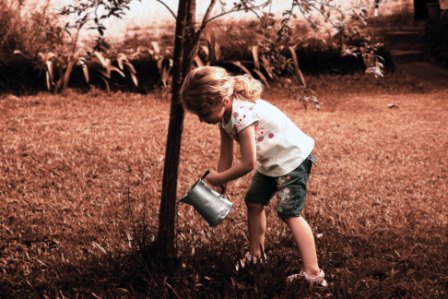
If I had a dollar for all the improperly planted trees I have seen over the years, I would be rich! First, dig the hole as deep as the root ball and at least twice as wide. Be sure to not dig too deep; a good way to prevent this is to measure the root ball against the shovel handle and check it often when digging. If you do dig too deep, remember to pack the soil firmly under the ball to prevent settling once the plant is in place.
This is more important for trees than shrubs. On the other hand, if the hole is not deep enough, keep digging. Don’t make the mistake of planting high and then mounding soil up around the root ball, even in clay soils. One exception is compacted clay subsoil, which can be found in new subdivisions. If you can’t dig deep enough, then add a lot of topsoil around the top of the root ball to make a gradual decline down to the grade level.
After the tree is in the hole, cut and remove as much of the wire cage (if present) as possible. Any part that you can’t remove should be cut and bent down. Untie the twine around the trunk and pull down the burlap. If the burlap is in good condition, push it to the bottom or cut it out. If it is old and roots are growing through, then leave it and make several vertical slices instead. If you are planting potted shrubs, carefully remove them from their pots and make several vertical slices down the root ball. Grab the bottom of the roots and pull them back up like peeling a banana and set them in the hole with the cut sections pointing out. Next, begin to backfill using the same soil that came out of the hole, making sure to break up any large chunks of soil. There should be no large air spaces left behind as you fill. Stop about 6 inches from the top and add fertilizer to the remaining fill, preferably either slow release or organic fertilizer that is low in nitrogen. Complete backfilling to grade level.
When you are planting trees or large shrubs, do not mix soil amendments such as sand, peat, or topsoil to the fill; these work better as top dressings. They actually create a false environment within the planting hole and do not encourage outward growth of the roots. Instead, the roots tend to wind around in the hole, which can eventually lead to girdling roots. Also, drainage can be a problem with dissimilar soils. Water will not move from one soil type to another until the first is completely saturated. This is why it is important to check the soil of the root ball before you buy the plant. Ideally, you should not plant trees grown in sand in clay soils and vice versa. It can only cause problems in the future.
Now that the plant is in the ground, water well and keep the soil moist for several weeks, but do not overwater. Before watering, move aside the mulch and feel the soil to verify it isn’t too wet before adding more water. Keep the mulch away from the trunk of the plant and do not add too much mulch — 3 to 4 inches is plenty.
Steve Turner, Certified Arborist, is from Arboricultural Services in Fenton, MI. He can be contacted at wecarefortrees@gmail.com.
Related Articles
Plant Propagation Calendar – What You Should Be Doing Each Month of the Year




Comment here